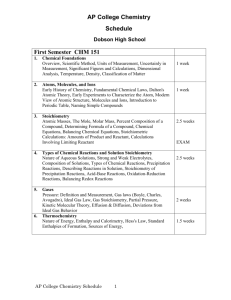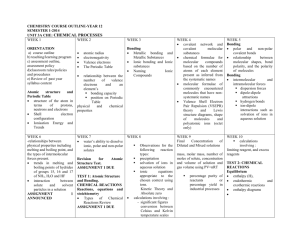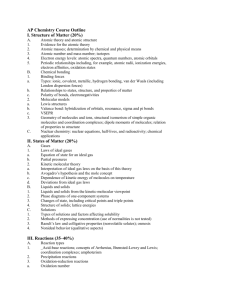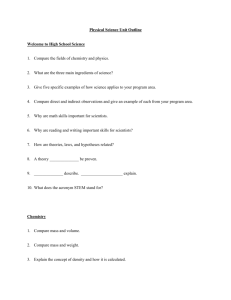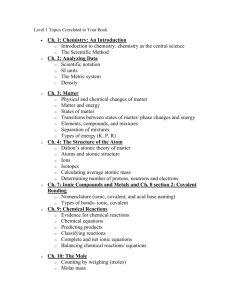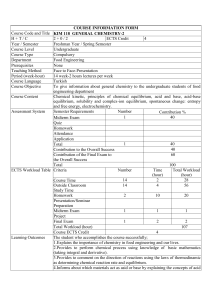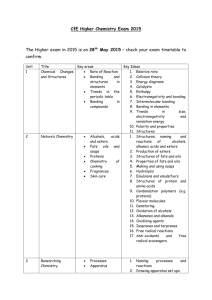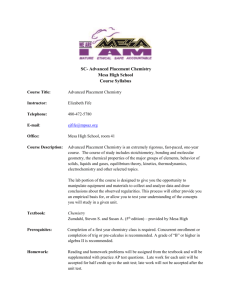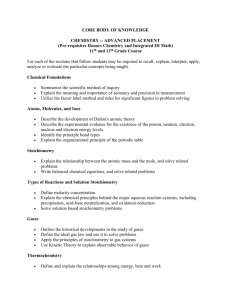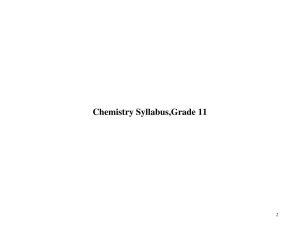Regents Curriculum Information
advertisement
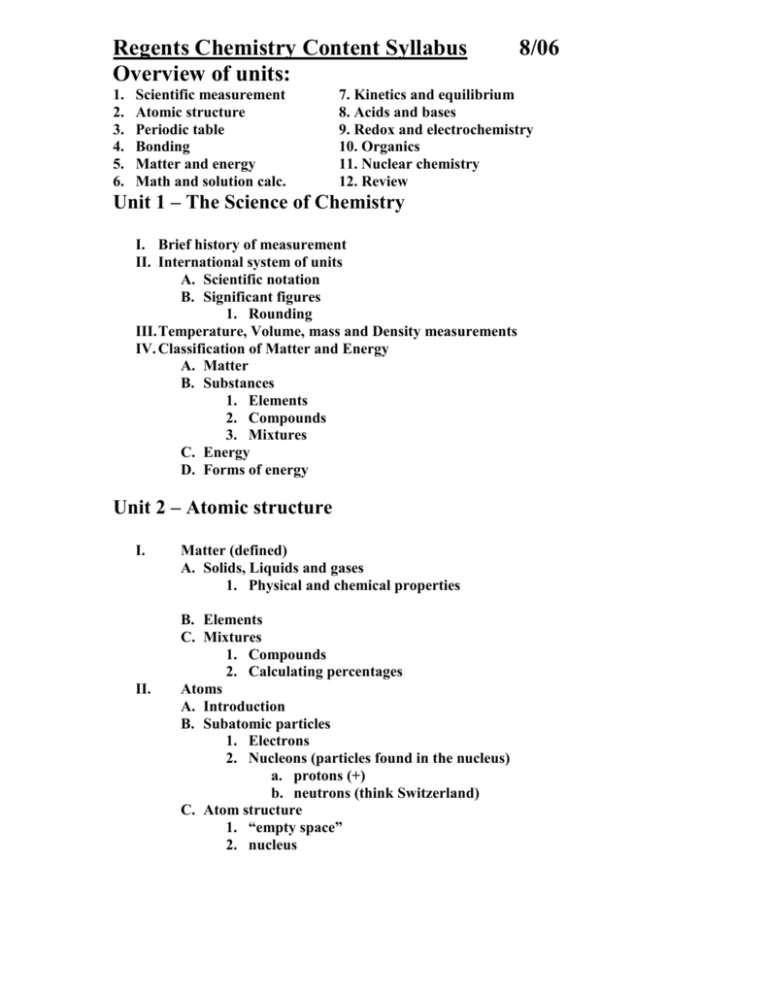
Regents Chemistry Content Syllabus Overview of units: 1. 2. 3. 4. 5. 6. Scientific measurement Atomic structure Periodic table Bonding Matter and energy Math and solution calc. 7. Kinetics and equilibrium 8. Acids and bases 9. Redox and electrochemistry 10. Organics 11. Nuclear chemistry 12. Review Unit 1 – The Science of Chemistry I. Brief history of measurement II. International system of units A. Scientific notation B. Significant figures 1. Rounding III. Temperature, Volume, mass and Density measurements IV. Classification of Matter and Energy A. Matter B. Substances 1. Elements 2. Compounds 3. Mixtures C. Energy D. Forms of energy Unit 2 – Atomic structure I. II. 8/06 Matter (defined) A. Solids, Liquids and gases 1. Physical and chemical properties B. Elements C. Mixtures 1. Compounds 2. Calculating percentages Atoms A. Introduction B. Subatomic particles 1. Electrons 2. Nucleons (particles found in the nucleus) a. protons (+) b. neutrons (think Switzerland) C. Atom structure 1. “empty space” 2. nucleus a. b. c. d. atomic number isotopes mass number atomic mass (weight) D. Atomic structure models 1. Brief summary of the history 2. Principal Energy Levels 3. Quanta 4. Spectral lines E. Orbital model 1. Energy levels a. Principle quantum numbers b. Sublevels c. Orbital 2. electron configurations 3. valence electrons F. Introduction to the Mole Unit 3 – Periodic table I. II. III. IV. V. VI. Development of Element properties – Physical a. Covalent atomic radius b. Ionic radius c. Metals d. Non-metals e. Metalloids or semi-metals Element properties – Chemical a. Valence electrons lost b. Filling the outer ring or shell Group chemistry a. Groups 1 and 2 (most metallic element) b. Groups 15 and 16 c. Group 17 (Most non-metallic element) d. Group 18 e. Transition elements Period chemistry Naming the elements Unit 4 – Bonding I. Nature of bonding – Why do chemical bonds form? E. Chemical energy F. Energy changes G. Bonding and stability H. Electronegativity differences II. Bonding between atoms a. Ionic i. Names ii. Formulas b. Covalent i. Names ii. Formulas (Molecular and Empirical) iii. Non-polar iv. Polar v. Coordinate covalent c. Metallic i. Elements that contain metallic bonds III. Molecular attraction a. Dipole-dipole b. Vanderwaals c. Hydrogen forces (not really a bond!) IV. Polarity and symmetry of covalent bonds a. Electron dot diagrams Types of Chemical reactions a. Parts of the chemical formula V. Unit 5 –Kinetic Molecular Theory (KMT) and Energy I. II. III. Matter (A review) Energy a. Forms of energy b. Energy and chemical changes i. Exothermic reactions ii. Endothermic reactions c. Measurement of energy i. Joules ii. Thermometry Phases of matter a. Gases i. Boyle’s law ii. Charles law iii. Combined gas law (equation) iv. Standard temperature and pressure (STP) v. Kinetic theory vi. Gas law deviations vii. Avogadro’s hypothesis b. Liquids i. Vapor pressure ii. Boiling point iii. Heat of vaporization c. Solids i. Heat of fusion ii. Sublimation Unit 6 – Mathematics of chemistry I. II. III. Mole interpretations Using moles a. Gram atomic mass b. Gram molecular mass c. Molar volume of a gas d. Mole road map Stoichiometry a. Types of reactions (a review) b. Balancing chemical equations c. Problems involving formulas i. Percent composition d. Problems involving equations i. Mole ratios ii. Mass-mass problems iii. Mass-volume problems iv. Volume-volume problems IV. Math involving solutions - concentration a. Methods of expressing concentration i. Molarity (M) ii. % by volume iii. Parts per million (ppm) b. Effects of solute on solvent (colligative properties) i. Crystals ii. Melting and freezing point (colligative properties) iii. Behavior of electrolytes Unit 7 – Kinetics and equilibrium I. II. III. Kinetics a. Role of energy i. Activation energy ii. Heats of reaction iii. PE diagrams b. Factors affecting reaction rates i. Nature of reactants (ionic vs. covalent) ii. Concentration iii. Temperature iv. Surface Area v. Catalysts Equilibrium a. Phase-change equilibrium (One substance) b. Solution Equilibrium i. Gases in liquids ii. Solids in liquids iii. Solubility c. Chemical equilibrium i. LeChatelier’s Principle 1. effect of concentration 2. effect of pressure 3. Effect of temperature 4. effect of a catalyst ii. Keq – equilibrium expressions Spontaneous reactions a. Energy changes b. Entropy changes Unit 8 – Acids and bases I. II. III. IV. Electrolytes Acids and bases a. Arrhenius theory of b. Bronsted Lowry Acid-base reactions a. Neutralization reaction i. Acid-base titrations ii. Salts Ionizations a. pH and concentrations of ions Unit 9 – Redox and electrochemistry I. II. Redox a. Oxidation b. Reduction c. Oxidation numbers d. Redox ½ reactions and balancing Electrochemistry a. Half-reactions b. Half-cells c. Chemical cells i. Electrodes 1. cathode 2. anode d. Electrolytic cells i. electroplating Unit 10 – Organics I. II. III. IV. Definitions Compounds and characteristics a. Bonding b. Structural formulas c. Isomers d. Saturated, Unsaturated Homologous series a. Alkanes b. Alkenes c. Alkynes Other compounds a. Alcohols i. Monohydroxy alcohols V. 1. primary 2. secondary 3. tertiary ii. dihydroxy alcohols iii. trihydroxy alcohols b. Organic acids c. Aldehydes d. Ketones e. Ethers f. Amides g. Polymers and polymerization i. Condensation polymerization ii. Addition polymerization h. Esters Organic reactions a. Substitutions b. Addition c. Fermentation d. Esterfication e. Saponification f. Combustion g. Others Unit 11 – Nuclear chemistry I. II. III. Natural radioactivity a. Emanations i. Alpha decay ii. Beta decay iii. Gamma radiation b. separating emanations c. Detecting radioactivity d. Half-lives Artificial radioactivity Nuclear energy a. Fission b. Fusion c. Uses of radioisotopes Tentative lab schedule: You are only allowed to miss 3 labs and still be eligible for the NYS Regents Exam. Lab # 1 2 3 4 5 6 7 8 9 10 11 12 13 14 15 16 17 18 19 20 21 22 23 24 25 26 27 28 29 30 Lab Name – concept Safety – Reference table preview Graphing and math practice Lab Techniques Density and error calculation Mendeleev and Indirect observations – development of the periodic table Flame tests – ground state vs. excited state Beanium lab – Calculating average atomic mass Periodic trends Puzzle pieces lab – Making and naming ionic compounds A chemical reaction: metal and S Move to lab # 17:Hydrate mass – calculating % by mass Molecular symmetry Conductivity – electrolytes and solution conductivity (write up #1) Separation of mixtures and solutions Heat transfer – Q=mCΔT Vapor pressure – Using reference Table H Physical and Chemical Changes / Types of chemical reactions Determining chemical compound composition - Coefficients Predicting mass of the product Mass of the solute in solution Colligative properties Solubility of curves – Using reference table G Cooling curves – moved to end Reaction rates Properties of Acids and Bases Titration – (Write up #2) Redox – electrochemistry Organic models Saponification - Esterfication Making Ice Cream Reference table review


